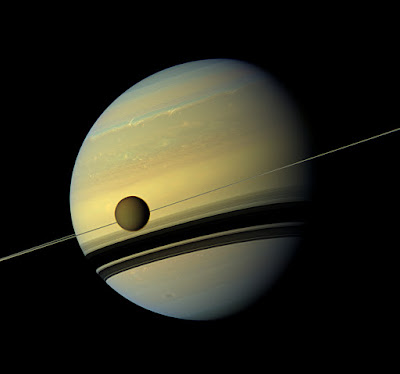
Titan moving away from Saturn faster than expected
Just as our own moon floats a little more from the earth each year, so do our other moons with their host planets. As the moon orbits, its gravity pulls on the planet, causing a temporary bulge as it passes through the planet.
Over time, the transition from this planet to the moon, and the energy generated by its transition, move it farther and farther away. Our moon moves 1.5 inches (3.8 cm) from Earth every year.
Scientists thought they knew the rate at which the moon Titan was moving away from Saturn, but they recently made a startling discovery: using data from NASA's Cassini spacecraft, they The Titan was found to flow a hundred times faster than previously thought - about 4 inches (11 cm) each year.
The results can help solve an old question. While scientists know that Saturn was formed in the early days of the solar system 4 billion years ago, there is more uncertainty about the planet's rotation and its more than 80 lunar systems. When was established? Titan is currently 759,000 miles (1.2 million kilometers) from Saturn. A revised rate of its growth suggests that the Moon began to come very close to Saturn, which would mean that the entire system expanded much faster than previously thought.
The result is a new piece of the puzzle for the highly debated question of the age of Saturn's system and how its moon was formed, "said Valerie Lenny, lead author of the work, published June 8 in Natural Astronomy. Said. He did research as a scientist at NASA's Jet Propulsion Laboratory in Southern California before joining the Paris Observatory at PSL University.
The findings on Titan's flow rate also provide significant support for a new theory that explains and predicts how planets affect their lunar orbits.
For the past 50 years, scientists have used the same formula to estimate how fast the moon moves from its planet, a rate that can also be used to determine the age of the moon. The formulas and classical theories on which they are based were applied to large and small moons throughout the solar system. Theories suggest that in systems such as Saturn, with dozens of lunar moons, outer moons such as Titan moved outward more slowly than near the moon because they are far from the gravity of their host planet.
Four years ago, astronomer Jim Fuller, now of Caltech, published a study that adopted these theories. Filler's theory predicts that the outer moon may also migrate to the inner moon at a similar rate because they are locked in a different type of orbital pattern that is connected to a particular planet's spectrum and out of them. Reduce to
"The new measurements show that the interaction of the moon of such a planet may be more significant than previously thought and that many systems, such as the lunar systems of other planets, eucalyptus - and beyond our solar system Can also be applied to the system where new stars orbit each other.
Tags:
astronomynews